San Marino
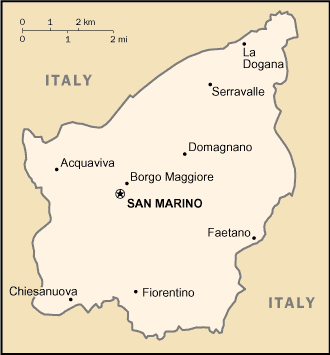
The third smallest state in Europe (after the Holy See and Monaco) also claims to be the world's oldest republic. According to tradition, it was founded by a Christian stonemason named Marino in 301 A.D. San Marino's foreign policy is aligned with that of Italy. Social and political trends in the republic also track closely with those of its larger neighbor.

OFFICIAL NAME:
Republic of San Marino
Geography
Area: 60 sq. km.;
Cities: Capital--San Marino (pop. 4,482). Other cities--Serravalle, Borgo Maggiore, Domagnano.
Terrain: Rugged mountains.
Climate: Mediterranean; mild to cool winters; warm, sunny summers.
People
Population (12-31-2002): 28,753
Ethnic groups: Sammarinese, Italian.
Religion: Roman Catholic.
Language: Italian.
Education: Literacy--96%.
Health: Infant mortality rate-3.3/1,000 live birth rates (2004). Life expectancy-78.6 for men and 84.9 for women (2004).
Work force: approx 18,000.
Government
Type: Republic. Constitution: October 8, 1600, electoral law of 1926 and manuscript of rights (1974) serve some of the functions of the Constitution.
Branches: Executive--Captains Regent (co-chiefs of state), Congress of State (cabinet) elected by the Great and General Council, Secretary of State for Foreign and Political Affairs (head of government). Legislative--unicameral parliament: 60-member Great and General Council. Judicial--Council of Twelve.
Administrative divisions: 9 municipalities.
Political parties: Christian Democratic Party, Democratic Progressive Party, San Marino Socialist Party, National Alliance, Popular Alliance, Communist Refoundation.
Suffrage: Universal over 18.
Economy
GDP (2002): Euros 935 million.
Per capita income (2002 est): Euros 24,054.
GDP growth (2004 est): 2%.
Natural resources: Building stone.
Agriculture: Products--wheat, grapes, maize, olives, cattle, pigs, horses, meat, cheese, hides.
Industry: Types--tourism, textiles, electronics, ceramics, cement, wine.
Trade: Exports—Euros 1,705 million (2001). 85% to Italy. Imports—Euros 1,744 million (2001) manufactured goods, food. Partners--Italy, Western Europe, Eastern Europe, South America, China, Taiwan.
PEOPLE AND HISTORY
The population of San Marino is comprised of native Sammarinese and Italian citizens. Crop farming, sheep farming, and the working of stone from the quarries formed the early backbone of San Marino's economy. It has no mineral resources, and today most of the land is cultivated or covered by woods.
According to tradition, San Marino was founded in AD 301 when a Christian stonemason named Marinus the Dalmatian fled to the island of Arbe to escape the anti-Christian Roman Emperor Diocletian. Marinus hid on the peak of Mount Titano and founded a small community of people following their Christian beliefs. It is certain that the area had been inhabited since prehistoric times, although evidence of existence on Mount Titano only dates back to the Middle Ages. In memory of the stonecutter, the land was renamed "Land of San Marino" and was finally changed to its present-day name, "Republic of San Marino."
The original government structure was composed of a self-governed assembly known as the Arengo, which consisted of the heads of each family. In 1243, the positions of Captains Regent (Capitani Reggenti) were established to be the joint heads of state.
The land area of San Marino consisted only of Mount Titano until 1463, at which time the republic entered into an alliance against Sigismondo Pandolfo Malatesta, Lord of Rimini, who was later defeated. As a result, Pope Pius II Piccolomini gave San Marino the towns of Fiorentino, Montegiardino, and Serravalle. Later that year, the town of Faetano joined the republic on its own accord. Since then, the size of San Marino has remained unchanged.
San Marino has been occupied by foreign militaries twice in its history, both for only short periods of time. In 1503, Cesare Borgia, known as Valentino, occupied the republic until his death several months later. In 1739, Cardinal Alberoni used military force to occupy the country. Civil disobedience was used to protest his occupation, and clandestine notes sent to the Pope to obtain justice were answered by the Pope's recognition of San Marino's rights and restoration of San Marino’s independence.
GOVERNMENT
The Arengo, initially formed with the heads of each family, relinquished its power to the Great and General Council. In 1243, the first two Captains Regent were nominated by the Council, and this method of nomination is still in use today. The Council is composed of 60 members who are elected every 5 years under a proportional representation system in all nine administrative districts. These districts (Townships) correspond to the old parishes of the Republic, and each one is ruled by a Council, which is chaired by a Captain elected every 5 years. The Great and General Council approves the budget, as well as the nominations of Captains Regent and heads of the Executive.
Every 6 months, the Council elects two Captains Regent to be the heads of state. The Regents are chosen from opposing parties so they can keep an eye on each other. They serve a 6-month term. The investiture of the Captains Regent takes place on April 1 and October 1 in every year. Once this term is over, citizens have 3 days in which to file complaints about the previous Regents' activities. If they warrant it, judicial proceedings against the former head(s) of state can be initiated.
The State Congress, composed of 10 Secretaries, wields executive power. The 10 Secretaries are (1) Secretary of State for Foreign and Political Affairs; (2) Secretary of State for Internal Affairs and Civil Defense; (3) Secretary of State for Finance, Budget and Programming, Information and Relations with the State Philatelic and Numismatic Office; (4) Secretary of State for Education, Culture, University and Justice; (5) Secretary of State for Territory, Environment and Agriculture; (6) Secretary of State for Health and Social Security; (7) Secretary of State for Trade and Relations with the Town Council; (8) Secretary of State for Communication, Transport, Relations with the Azienda Autonoma di Stato for Services, Tourism, and Sport; (9) Secretary of State for Industry and Crafts; and (10) Secretary of State for Labor and Cooperation.
The Great and General Council elects the Council of Twelve for the duration of the Legislature and serves a jurisdictional body that also acts as a third instance Court of Appeals. Two government inspectors represent the State in financial and patrimonial questions.
The Legislative body consists of the Great and General Council, the parliament, and a unicameral Chamber. The members of parliament are usually elected every five years and are in charge of legislation, justice, and the administration of jurisdiction. In addition, they are tasked with electing the Captains Regent, the State Congress, the Council of Twelve, the Advising Commission, and the Government Unions once the Council nominates them. Parliament also has the power to ratify contracts with other countries. The parliament is divided into five different Advising Commissions consisting of 15 councils which examine, propose, and discuss the implementation of new laws that are on being submitted to the Great and General Council.
The judicial system of San Marino is entrusted to foreign executives, both for historical and social reasons. The only native judges are the Justices of the Peace, who only handle civil cases where sums involved do not exceed 25 million lire. The Council of Twelve serves as an appeals court in the third instance.
POLITICAL CONDITIONS
San Marino is a multi-party democratic republic. The three main parties are the Democratic Christian Party of San Marino (PDCS), the Socialist Party of San Marino (PSS), and the Progressive Democratic Party of San Marino (PPDS), in addition to several other smaller parties. Due to the small size and low population of San Marino, it is difficult for any party to gain a pure majority, and most of the time the government is run by a coalition. Following a period of political instability after the June 2001 elections, in December 2003 the three largest parties formed a coalition government with a view to reforming the electoral law and subsequently calling for early elections.
Because tourism accounts for more than 50% of the economic sector, the government relies not only on taxes and customs for revenue but also the sale of coins and postage stamps to collectors throughout the world. In addition, the Italian Government pays San Marino an annual budget subsidy provided under the terms of the Basic Treaty with Italy. In recent years banking has also become an important economic activity.
Harmonization of statutes and policies with the EU is a major domestic and foreign policy priority of the republic. Another priority issue will be to increase the transparency and efficiency in parliament and in relations among parliament, cabinet, and the Captains Regent.
ECONOMY
San Marino's per capita GNP in 2002 stood at 24,054 Euros with more than 50% coming from the tourism industry, which draws about 3 million people annually. One of the greatest sources of income from tourism comes from the sale of historic coins and stamps. In 1894, San Marino issued its first commemorative stamps, which produced government revenue for the republic. All 10 of the Post Offices of San Marino sell these stamps and collectable coins, including "Legal Tender Gold Coins."
Traditional economic activities in San Marino were food crops, sheep farming, and stone quarrying. Today farming activities focus on grain, vines, and orchards, as well as animal husbandry (cattle and swine). Besides the tourism industry, San Marino makes most of its income from the banking industry and from the manufacture and export of ceramics, tiles, furniture, clothing, paints, fabrics, and spirits/wines. The per capita level of output and standard of living in San Marino are comparable to those of Italy. In addition, San Marino maintains the lowest unemployment rate in Europe and no national debt.
FOREIGN RELATIONS
San Marino is an active player in the international community. Currently, the Republic has diplomatic relations with over 70 countries. Italy is the only country represented by an ambassador resident in San Marino. The Papal Nuncio, based in Rome, is the dean of San Marino’s diplomatic corps.
San Marino is a full member of the United Nations, International Court of Justice, United Nations Educational, Scientific and Cultural Organization (UNESCO), International Monetary Fund (IMF), World Health Organization (WHO), World Tourism Organization (WTO), Council of Europe, International Red Cross Organization, and the International Institution for the Unification of Private Law (UNIDROIIT), among others. It also cooperates with UNICEF and the United Nations High Commission for Refugees and has official relations with the European Union. From May 10 until November 6, 1990, San Marino held the semi-annual presidency of the Committee of Ministers of the Council of Europe, headquartered in Strasbourg, France.
| Reverse side | Front side | Description |
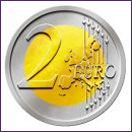 |
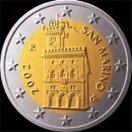 |
2 Euro: Il Palazzo Pubblico - "The Public Palace". |
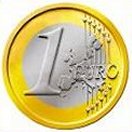 |
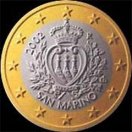 |
1 Euro: The official coat-of-arms of the Republic of San Marino. All the obverse designs are from sketches by Frantisek Chochola, and engraved by Ettore Lorenzo Frapiccini. |
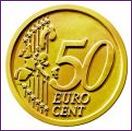 |
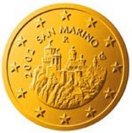 |
50 Euro Cents: The Three Towers, La Guaita, La Cesta, and Il Montale. |
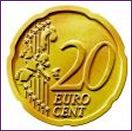 |
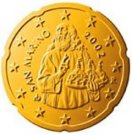 |
20 Euro Cents: Il Santo Marino ispirato a una tela della Scuola del Guercino - St. Marino pictured holding the the Three Towers, inspired by the School of Guercino. |
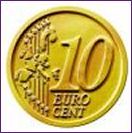 |
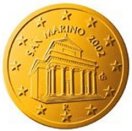 |
10 Euro Cents: The Basilica of San Marino. |
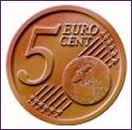 |
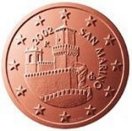 |
5 Euro Cents: The First Tower - La Guaita. |
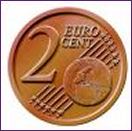 |
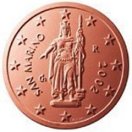 |
2 Euro Cents: The Statue of Liberty, by Stefano Galletti. |
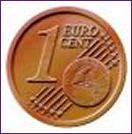 |
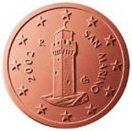 |
1 Euro Cent: The Third tower, Il Montale. |